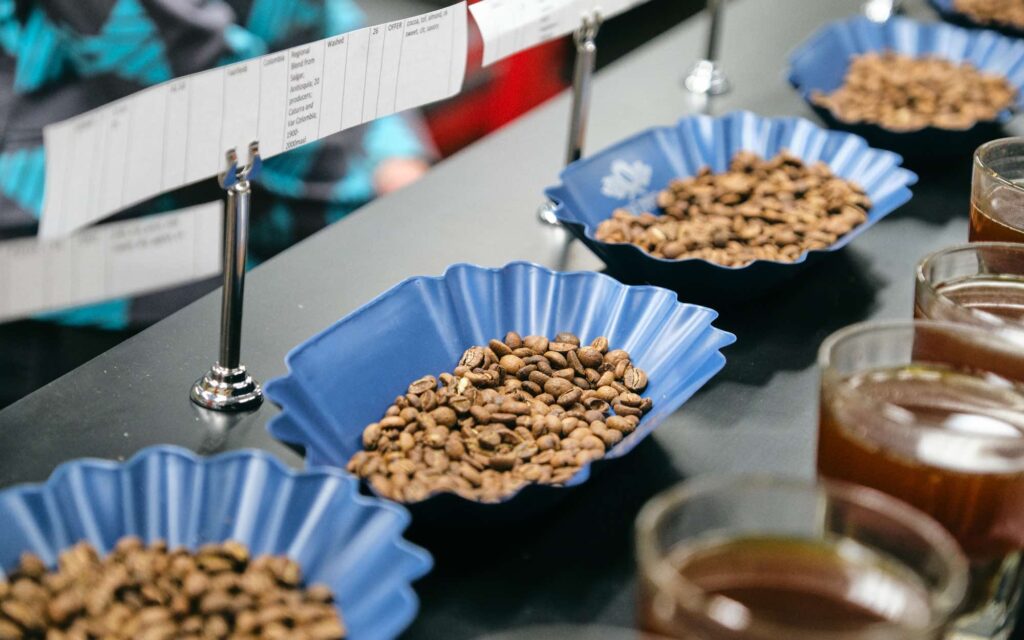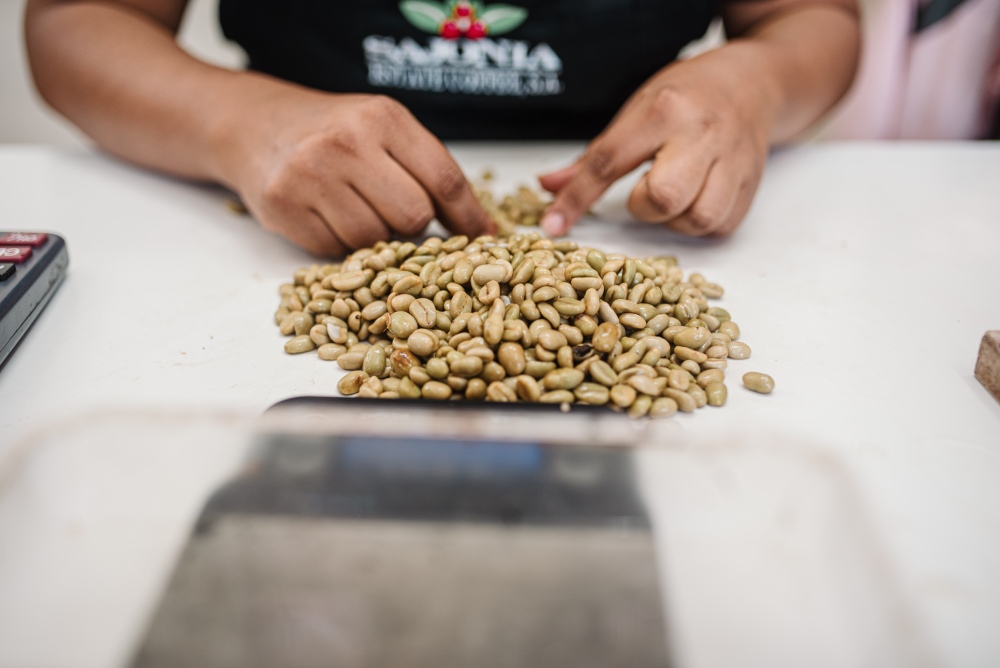An introduction to the Coffee Character Wheel
Global Coffee Report talks to Dr Simon Williams and Danny Andrade about the development of the Coffee Character Wheel, a new industry tool to standardise sensory terms.
Describing the flavours of coffee has just become a whole lot easier.
Southern Cross University (SCU) and education platform Processing Methods Bootcamp, in conjunction with research organisation AgriFutures Australia, have unveiled a Coffee Character Wheel to homogenise the way the global coffee industry refers to the sensory terms acidity, mouthfeel, and aftertaste.
“Flavour can be very subjective, depending on your background, memories, and taste preferences. The Coffee Character Wheel, which focuses on characteristics, is more objective and allows people to agree easily on coffee descriptors,” says 2023 Australian Coffee in Good Spirits Champion (CIGS) and Founder of Processing Methods Bootcamp Danny Andrade.
The Coffee Character Wheel is a colour-coded visual glossary of terms, created to establish a common language for producers and consumers.
“Many sensory terms have been used to describe these attributes, but there is no clear summary or discussion around the terms used. By analysing the terms used currently we can create mutual descriptors for coffee character,” says SCU’s adjunct researcher Dr Simon Williams.
Andrade says it is important to expand the conversation around acidity, aftertaste, and mouthfeel descriptors so the global coffee industry is on the same page.
“For example, traditionally, if I talk about a coffee that has floral aromas and berry fruity notes, you might guess it’s a natural processed Geisha from Panama, as Panamanian Natural coffees often have these flavour notes descriptors. But suppose I say the coffee has floral aromas, with notes of blueberry, and has bright, vibrant acidity. In that case, it’s much easier to identify that the coffee might be from Ethiopia,” he says.
“Coffee is also evolving very fast, thanks to experiments in fermentation and post-harvesting processing, which contributes to the characteristics of coffee. These descriptors will help coffee professionals identify and express the fermentation and post-harvest processes used.”
Williams says the Coffee Character Wheel expands on the original Specialty Coffee Association (SCA) Coffee Taster’s Flavor Wheel by including what they believe were the previously missing elements.
“For coffee aroma and flavour, we standardise to the well-known Coffee Taster’s Flavour Wheel. However, during our tasting panels, we also identified many coffee descriptions for Australian-grown coffee beans related to coffee acidity, mouthfeel, and aftertaste. These descriptions have not been discussed widely in the literature,” he says.
“The acidity, mouthfeel, and aftertaste are also essential characteristics of coffee. We summarised these descriptions and created the world-first Coffee Character Wheel.”
More than flavour
Williams and Andrade, in collaboration with SCU Researcher Dr Ben Liu, helped develop a research paper published in the Journal of Sensory Studies that explores the creation of the Coffee Character Wheel. The process involved collecting thousands of coffee descriptions from cupping panels and coffee literature.
“Danny provided industry support and advice, and helped us run the coffee panels. He also assisted with the language used in the research paper, ensuring it made sense to the people in the industry,” Williams says.
“I developed much of the data analysis and set the guides to ensure we had minimal overlap with descriptors already on the [SCA] Flavor Wheel.”
According to the research paper, coffee is assessed and marketed on its fragrance/aroma, flavour, aftertaste, acidity, and body/mouthfeel. Yet, only the fragrance/aroma and flavour have standardised sensory descriptors and lexicons. The World Coffee Research (WCR) Sensory Lexicon has standardised aroma and flavour sensory terms to create a common sensory vocabulary for research and industry.
“Currently, coffee professionals and researchers use a range of descriptors, with some terms used interchangeably and others overlapping with flavour terms,” Williams says.
Coffee gains its acidity from its combination and intensity of chlorogenic acids, carboxylic acids, and phosphoric acid. Coffee acidity can be described in three ways: the pH of the coffee representing the dissociation of ions into the coffee from acids contained in the coffee, the sour taste imparted to the coffee from said acids, and the character provided to the coffee from the acids. Coffee pH can be measured via instrumentation, and the sour taste can be described using the WCR Sensory Lexicon. Many sensory terms such as bright, sharp, mellow, low, and flat describe the character of the acidity when coffee is assessed. However, little research has been carried out to summarise the sensory terms used to portray the character of coffee acidity.
The study says the tactile experience of drinking coffee is often described by the coffee’s body or mouthfeel, with the two terms used interchangeably. Body is favoured when reporting on the quality of coffee, as it forms one of the assessed categories in the standard industry method. However, the term mouthfeel is used more broadly within coffee literature and other industries when a more detailed description of the tactile response is required. In general, mouthfeel covers the texture and body of the coffee. Body reflects the weight and viscosity of the coffee. According to the study, though there is agreement in using ‘mouthfeel’ as a broad primary term, a range of related but different secondary terms provide more specific descriptions.
Aftertaste or finish is the residual sensory experience that remains in the mouth after the coffee is removed, according to the research paper. The residue coats the oral cavity and releases volatile compounds which are detected as the aftertaste. The released chemicals in the residue correlate with the least soluble compounds that generally belong to the nutty/cocoa, roasted, or chemical flavour groups found in the WCR lexicon.
“We realised there were a lot of similar descriptors of flavour, especially for mouthfeel and acidity, used by our panellist cuppers. There was a lot of misunderstanding about the difference between flavours and the characteristics of the coffee, what words like ‘apple’ or ‘heavy’ or ‘full’ actually meant, because there was no tool to guide them,” Andrade says.
A total of 679 unique sensory terms identified for acidity, mouthfeel, and aftertaste were distilled into a total of 95 terms, and included an overall grouping for shared terms. The reduced terms were arranged onto a Coffee Character Wheel organised from broad to specific to assist cuppers.
“During our coffee panels investigating the terroir of Australian-grown coffee, the list of descriptors was getting out of hand, so we brought in earlier versions of the Coffee Character Wheel which helped impose some control over how many sensory terms we had,” Williams says.
Andrade says the study was released at “the perfect time” (in September 2023), right before he won the 2023 Australian CIGS.
“I was able to use the interest from competing in the worlds to boost the promotion of the Coffee Character Wheel as an education tool,” he says.
The wheel is currently available to download for free on AgriFutures’ website, titled ‘Defining the terroir of Australian coffee’.
Aussie made
The Coffee Character Wheel was also designed to help build demand for Australian-grown coffee beans. According to SCU, the green bean market in Australia is worth AUD$1 billion, yet the majority of beans are sourced internationally. What’s unique about Australian-grown coffee, is a set of characteristics unlike any other region.
“Using the Coffee Character Wheel, Australian-grown coffee has been described as having a low-medium intensity acidity with citric acid and malic acid characters similar to apple and berry, a smooth texture and light medium body mouthfeel, a medium-long aftertaste, and flavours described as fruity and nutty,” Williams says.
“This sort of information will allow us to inform consumers that Australia is a sophisticated and established coffee producer with enormous potential based on the unique characteristics of the region where that coffee is grown and produced.”
AgriFutures Australia and SCU have produced the ‘Defining terroir of Australian coffee to increase demand and investment report’ which summarises an investigation into coffee terroir, especially the terroir of Australian-grown coffee.
More than 100 Australian-grown single-origin green beans from 28 farms were analysed, along with an additional 50 international single-origin green beans. The green beans were roasted using a fixed roast profile to ensure equal treatment and then tasted by 15 coffee panels across Australia. The panellists included coffee growers, green bean buyers, roasters, baristas, trainers, and coffee judges.
“The coffees were de-identified and given to 138 panellists to taste at our coffee-tasting panels. We also generated comprehensive chemical fingerprints of the brewed coffee prepared for our panels. The coffee descriptions and chemical fingerprints of the brewed coffee were analysed by machine learning algorithms. A machine learning model was also created to predict coffee terroir based on chemical fingerprints alone,” Williams says.
“We used word clouds to highlight the sensory terms used by panellists to describe the coffee terroir. Even though we provided the [SCA] Flavor Wheel and our Coffee Character Wheel during the assessment, panellists still used a range of sensory descriptors outside of those on the wheels.
“We confirmed that Australian-grown coffee is sweeter, nuttier and fruitier in flavour. This pleasant terroir is probably due to the cooler temperature in our coffee-producing areas.”
Williams says the produced terroir profiles will enable coffee producers to define and communicate the unique characteristics and flavours of their coffee based on published research.
“Allowing Australian coffee to differentiate itself in the global market can potentially result in higher prices due to its distinct qualities. With a more well-defined understanding of the terroir and its impact on coffee flavour, consumers who appreciate high-quality specialty coffee may develop a stronger preference for Australian single-origin coffee,” Williams says.
“This could increase demand for Australian coffee in domestic and international markets, improve efficiencies, and lower production costs.”
Williams adds that increasing industry cooperation will create more resources within the Australian coffee industry.
“The flow of ideas can lead to a growth of interest in the industry, leading to increased demand, investment opportunities to increase current coffee farm size, or the establishment of new coffee farms,” he says.
Coffee professionals utilised the project cupping panels to establish connections and communicate ideas.
Williams says establishing regular cuppings of Australian-grown coffee, facilitated by a third party, would create opportunities for coffee professionals to come together and discuss Australian coffee with less perceived bias. He says events open to the public would also allow Australian-grown coffee to reach larger audiences.
“Industry cooperation, with a focus on promoting the unified Australian coffee terroir of sweet, nutty, and fruity flavours, can give Australian-grown coffee a competitive advantage against international coffee, especially in the domestic market,” he says.
This article was first published in the March/April 2024 edition of Global Coffee Report. Read more HERE.
The post An introduction to the Coffee Character Wheel appeared first on Global Coffee Report.





Responses